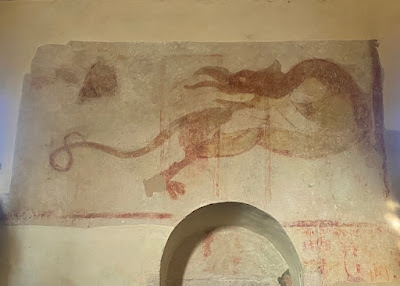Emerging from the mere
Almost the first thing you see when entering the church of St Mary at Wissington* is a large wall painting of a dragon, high on the north wall. It’s dated to the 14th century and may relate to an account in a chronicle of 1405 by the monk Henry de Blaneford of St Albans Abbey. Henry tells how a dragon appeared from a mere or marshy area near Bures. It was a creature with a long body and tail, a crested head, and saw-like teeth. It was said to have killed a herd of sheep near Bures and its hard skin repelled the arrows of those who gathered to try and kill it. The chronicler goes on:
The servants of Sir Richard Waldegrave who owns the land haunted by the dragon came forth to shoot it with arrows which sprang back from its ribs as if they were metal of [or?] hard stone and from the spines of its back with a jangling as if they were hitting bronze plates, and flew far away because its skin was impenetrable. Almost the whole county was summoned to slaughter it but when it saw that it was to be shot at again, it fled into the marsh, hid in the reeds and was seen no more.
Some say that the village of Wormingford near Bures may have taken its name from the dragon or worm (the latter being an old word for a serpent or dragon).† It’s certainly true that the association of the beast with the local area has not gone away. In 2012, the Jubilee year of Queen Elizabeth II, the figure of a large dragon was cut into a hillside near Bures.
The dragon in medieval Christianity is a symbol of destructive evil, particularly the evil associated with paganism. He also represents Satan. You often find the dragon represented with St George, as part of the story in which the saint kills the evil creature. St Margaret of Antioch is another saint associated with a dragon – she escaped after being swallowed by the creature. St Michael is another dragon-slaying saint. Sometimes the dragon is seen alone as a warning against evil. The position of the creature in this painting, high up and quite near the roof, made me doubt at first that he was originally accompanied by one of the dragon-slaying saints. There is no obvious evidence of a figure near the beast, and the background of the image is confused because it seems to have been painted over an early picture. Given the legend about the Bures dragon, however, the painting carries a strong local, as well as a more general Christian, resonance.
- - - - -
* Also known as Wiston
† It was originally Widermund’s or Withermund’s ford, but it’s possible that the change to Wormingford may have been due, in whole or in part, to the legend of the dragon. Ronald Blythe, who lived near Wormingford, was one advocate of the derivation from the dragon – see the excellent selection of his writings, Next to Nature (2022).

Thanks for this post, Phil. It's a beautifully fluid image, with twists and curls from its jaws to the tip of its tale, and artfully composed to fit the long body inside a rectangular frame. Is there some ambivalence in the way the creature is viewed, a force of destruction but a thing of beauty? The chronicler presents it as both dangerous and endangered. Perhaps even then there was some inclination to side with the dragon.
ReplyDeleteJoe: Thank you for your comment. I agree about the beauty of the image, but in the Middle Ages, beauty could be seen as something suspicious, as potentially tricking us into thinking the beautiful person or creature benign. And yet, I'm open to the idea that symbols in churches can have more than one meaning (even contradictory meanings) simultaneously.
ReplyDelete